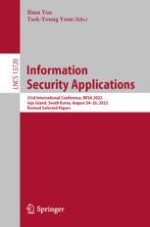2023 | Buch
Information Security Applications
23rd International Conference, WISA 2022, Jeju Island, South Korea, August 24–26, 2022, Revised Selected Papers
herausgegeben von: Ilsun You, Taek-Young Youn
Verlag: Springer Nature Switzerland
Buchreihe : Lecture Notes in Computer Science
